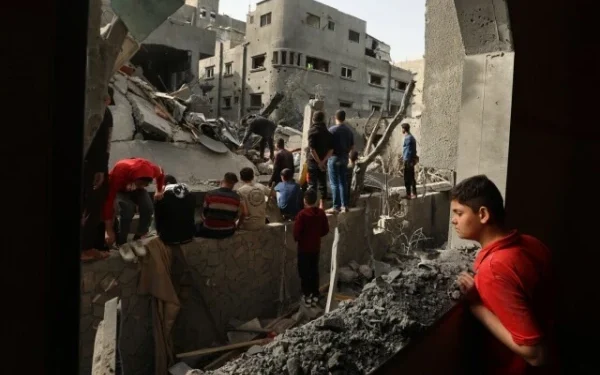Introduction: Mounting Humanitarian Crisis in Gaza
The humanitarian catastrophe in Gaza continues to deepen as the death toll rises alarmingly. According to the latest figures released by the Gaza Health Ministry, 58 more Palestinians lost their lives and 213 others were wounded in the last 24 hours alone due to relentless Israeli airstrikes and artillery shelling. The grim escalation has pushed the total number of Palestinians killed in the conflict to 50,810, with more than 115,688 reported injuries since the war began on October 7, 2023.
Escalation Since the Ceasefire Collapse
The most recent wave of violence follows the collapse of a brief ceasefire that ended on March 18, 2024. Since then, Israeli operations have intensified, resulting in the deaths of at least 1,449 Palestinians and injuries to 3,647 more. This sharp rise in casualties underscores the fragility of the region’s security and the profound challenges facing humanitarian actors on the ground.
A Warzone Without Safe Zones: Civilian Suffering at Its Peak
The Gaza Health Ministry has highlighted that many of the recent casualties include women, children, and the elderly, many of whom were in areas presumed to be “safe zones.” In reality, no place in Gaza is truly safe. Residential buildings, hospitals, schools, mosques, and even refugee camps have not been spared.
According to multiple aid agencies and eyewitness reports, several bodies are still trapped under rubble or lying exposed on the streets. Due to continued bombardment and the collapse of emergency response systems, ambulances and civil defense teams are unable to reach many of these areas. In some zones, Israeli blockades and ongoing air raids have made rescue operations virtually impossible.
The Scope of Destruction: Targeting of Civil Infrastructure
Since the war began, Israel has been accused of systematically targeting civilian infrastructure under the justification of rooting out Hamas militants. Hospitals like Al-Shifa and Al-Quds, as well as UN-run schools and shelters, have either been bombed or rendered non-operational due to nearby military activity.
Reports from international organizations, including the United Nations Relief and Works Agency (UNRWA), suggest that thousands of families have been displaced multiple times. With Gaza’s borders effectively sealed and essential supplies restricted, these internally displaced people have nowhere to go and are forced to live in overcrowded and unsafe conditions.
Humanitarian Access Severely Restricted
The situation has become dire for humanitarian workers. Aid convoys struggle to enter Gaza due to tight Israeli security measures and constant air raids. Hospitals are overwhelmed, understaffed, and running low on essential medical supplies like antibiotics, anesthetics, and surgical tools. Health professionals report having to perform surgeries without adequate resources, sometimes even without electricity.
Fuel shortages have crippled critical services, including water desalination plants and electricity generation. Most areas of Gaza now rely on just a few hours of power each day—if any—making food preservation and clean water access a growing crisis.
Global Reaction: Calls for Ceasefire and Accountability
The staggering human cost of the conflict has drawn widespread international condemnation. The United Nations, the European Union, and several non-governmental organizations have urged both sides to return to the negotiating table and establish a permanent ceasefire.
UN Secretary-General António Guterres called the ongoing death toll “unacceptable” and reiterated calls for an immediate humanitarian ceasefire to allow aid to reach those in need. Meanwhile, organizations such as Amnesty International and Human Rights Watch have continued to investigate potential war crimes committed during the conflict by both parties.
Israel’s Position: National Security vs. Civilian Impact
Israeli authorities maintain that their military actions are targeted strikes aimed at eliminating the Hamas leadership and their military infrastructure, which they claim is embedded within civilian areas. The Israel Defense Forces (IDF) has repeatedly stated that it gives advance warnings to civilians before conducting operations in specific neighborhoods.
However, critics argue that the disproportionate scale of destruction and civilian deaths far outweighs any justifiable military objective. Human rights groups have called on Israel to adhere strictly to international humanitarian law, which requires distinction and proportionality in armed conflict.
Palestinian Voices: Stories of Loss and Resilience
Amid the statistics and headlines are the real human stories of grief, resilience, and survival. Families torn apart, children orphaned, and entire communities erased in moments.
Local media has reported stories of fathers digging through rubble with bare hands to recover the bodies of loved ones, doctors working 20-hour shifts under siege conditions, and mothers walking miles for water or a scrap of bread to feed their children.
Despite the odds, Palestinian civilians continue to demonstrate courage. Volunteers from local communities and civil organizations risk their lives daily to assist the wounded and distribute food and medicine. Their bravery, often overlooked, represents the indomitable spirit of a population struggling to survive under the weight of unrelenting war.
Regional and Geopolitical Implications
The ongoing war in Gaza has also heightened tensions across the Middle East. Regional powers such as Egypt, Qatar, Turkey, and Iran have taken varied stances, ranging from offering mediation to providing military and financial support to different factions. The potential for spillover conflict into neighboring Lebanon and Syria remains a concern for global policymakers.
In the United States and European countries, public opinion has become increasingly polarized, with large-scale protests demanding an end to the violence and accountability for the high civilian death toll.
Future Outlook: Is Peace Possible?
The prospects for lasting peace in the region remain uncertain. Diplomatic efforts have so far yielded temporary truces, but without a comprehensive political resolution that addresses core issues such as occupation, sovereignty, borders, and the rights of Palestinians, the cycle of violence is likely to continue.
Efforts are now being directed toward renewing talks through international forums, but with each passing day and each lost life, mutual distrust deepens, making reconciliation ever more difficult.
Conclusion: A Humanitarian Tragedy That Demands Urgent Action
With more than 50,810 lives lost and 115,688 injuries reported, the conflict in Gaza is no longer just a regional crisis — it is a humanitarian disaster of international concern. The international community must act decisively to stop the bloodshed, ensure accountability for violations of international law, and provide critical humanitarian assistance to the people of Gaza.
Until meaningful and sustained peace efforts are implemented, the people of Gaza will continue to bear the brunt of a war they did not choose — and the death toll will continue to rise.

























